Our Highton Podiatrist, Marney Cowell, is going to explain what the bump may be on the back of your heel and what you can do to avoid it becoming a problem.
Have you noticed a hard bump on the back of your heel and have no idea what it is? Well it may be Haglund’s Deformity.
-
What is Haglund’s Deformity?
Haglund’s Deformity is the bony prominence on the back of your heel, near where your achilles inserts.You may notice the bump getting larger, more painful or red and inflamed when it has been aggravated.
-
Can I get rid of the bump on the back of my heel?
Depending on the stage of the deformity it is unlikely to recede back to a flat surface, although there are plenty of treatment options available.
Why is it called Haglund’s Deformity?
Patrick Haglund first described this condition in 1927, which would suggest that it is a relatively recent issue affecting us. It also is commonly called a ‘pump bump’ which refers to its increased incidence in the high heel shoe wearing population. It is more common in females than males.
What causes Haglund’s Deformity?
Haglund’s deformity arises from an increased pressure at the back of the foot.
- Footwear – If your footwear is too tight or too stiff you are increasing the pressure to the back of your foot. The more pressure that is applied the bigger the bump can get.
It can start to rub on footwear, wearing out the back of your shoes and even become inflamed. - Tight calf muscles – You are also at risk of a haglund’s deformity if you have tight calf muscles or trouble with your achilles. The achilles attaches the back of our heel and the tighter your calf muscles/achilles are the more likely you are to develop a haglund’s deformity.
What should I do if I have one?
First and foremost, see your Podiatrist.
- Your Podiatrist will be able to help with determining the cause of the deformity
- They may even get an x-ray to confirm the diagnosis as it is easily mistaken with other conditions that affect that area such as achilles tendonitis.
- Make footwear suggestions or alterations to your current footwear with offloading padding
- They will also help address any biomechanical reason why the deformity is occurring with the use of orthotics, foot mobilisation or stretching programs
- In severe cases we may refer for a surgical opinion, although this is certainly a last resort. The procedure to surgically excise a Hagland’s is not as straightforward as it may sound and has significant healing times.
If you have any questions about Haglund’s deformities, bumps/ lumps or foot questions in general, please contact us on 52905238 or book online.
Marney Cowell
Podiatrist
marney@prosperhealthgroup.com.au
